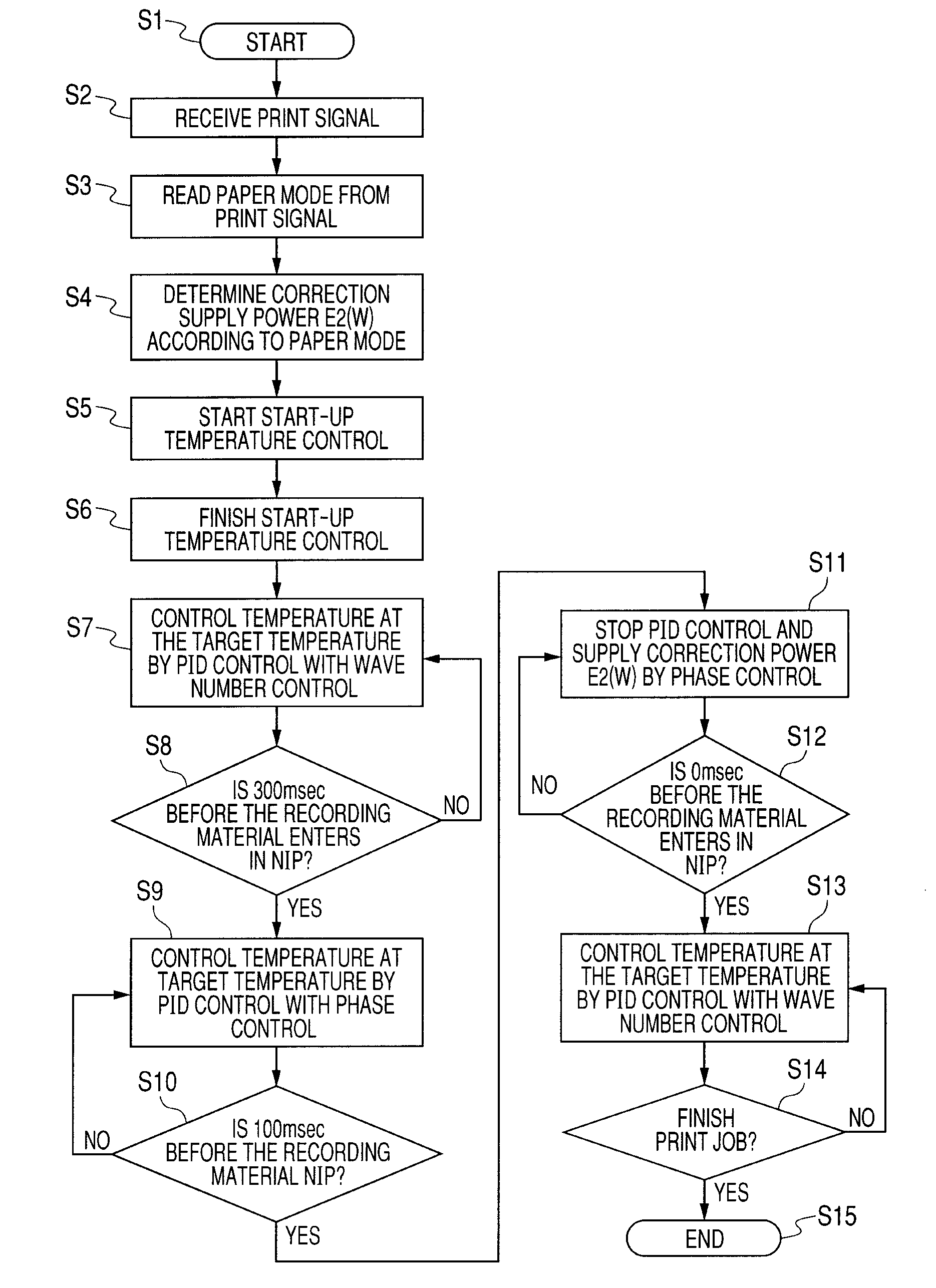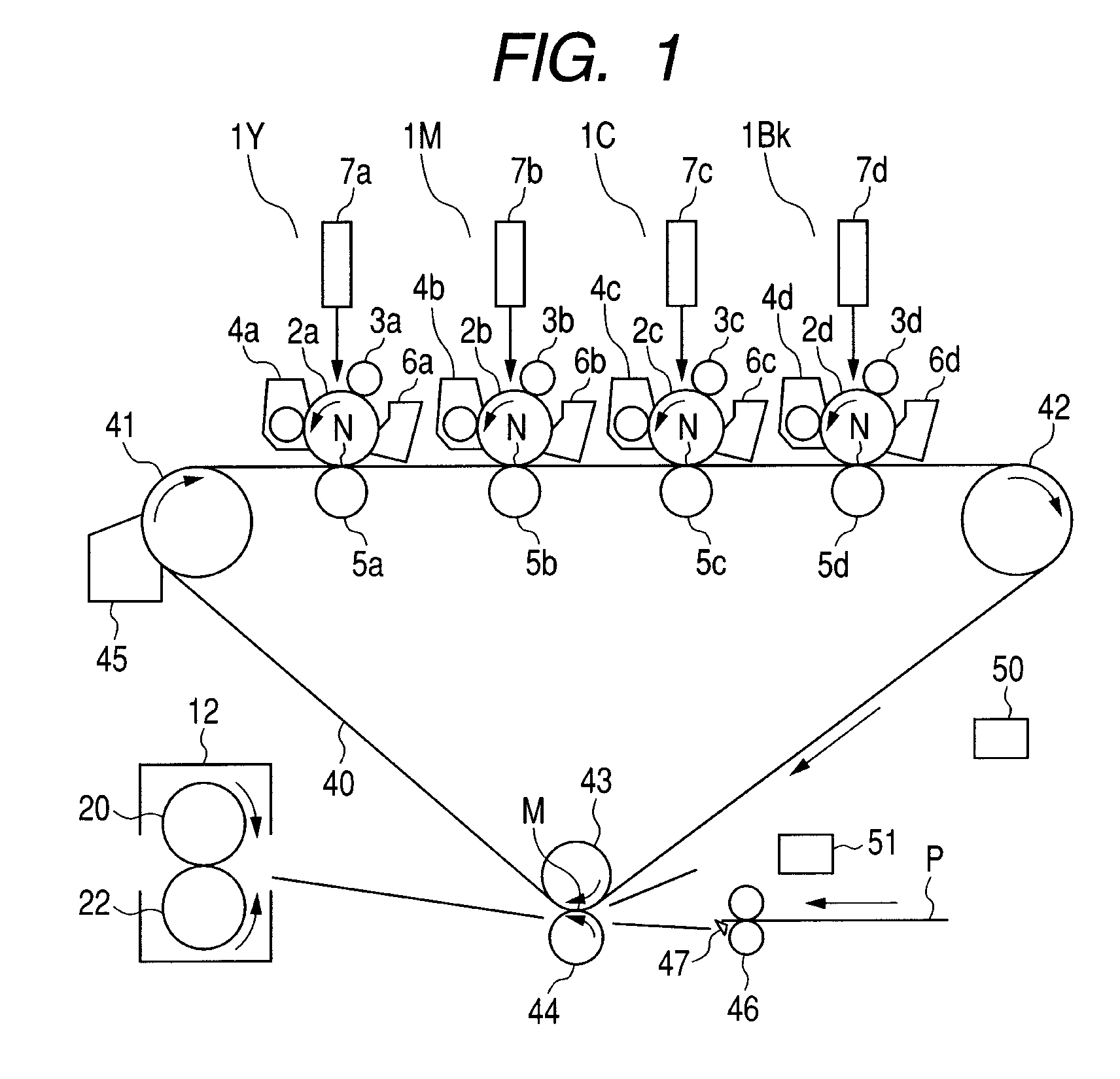Image forming apparatus
a technology of image forming apparatus and forming tube, which is applied in the direction of electrographic process apparatus, instruments, optics, etc., can solve the problems of delay in switching power supply ratio, higher cost of apparatus in the case of phase control, and inability to provide appropriate power
- Summary
- Abstract
- Description
- Claims
- Application Information
AI Technical Summary
Benefits of technology
Problems solved by technology
Method used
Image
Examples
first exemplary embodiment
[0078]FIG. 1 schematically illustrates a configuration of a color image forming apparatus according to a first embodiment of the present invention. The image forming apparatus according to this exemplary embodiment is a tandem type electro-photographic full-color printer.
[0079]The image forming apparatus includes four image forming portions, i.e. an image forming portion 1Y for forming an yellow image, a magenta image forming portion 1M, a cyan image forming portion 10, and a black image forming portion 1Bk, and those four image forming portions are arranged in a line with a predetermined distance therebetween.
[0080]The respective image forming portions 1Y, 1M, 1C, and 1Bk include respective photosensitive drums 2a, 2b, 2c, and 2d. Around the respective photosensitive drums 2a, 2b, 2c, and 2d, there are disposed, respectively charging rollers 3a, 3b, 3c, and 3d, developing devices 4a, 4b, 4c, and 4d, transfer rollers 5a, 5b, 5c, and 5d, and drum cleaning devices 6a, 6b, 6c, and 6d. ...
second exemplary embodiment
[0183]In the first exemplary embodiment, wave number control is mainly used for controlling the power supply ratio when the power is supplied. In the exemplary embodiment, control combining wave number control and phase control is used. In this case, the power supply ratio in a predetermined cycle is controlled by always including a waveform for supplying power 100% or supplying no power (0% power supply) with respect to one half wave within a predetermined cycle as in the case of the wave number control, and including a waveform for controlling a power supply angle with respect to one half wave within the same cycle, to perform phase control. This control is defined as “hybrid control”.
[0184]More specifically, the hybrid control is basically wave number control with several waves of one half wave or more set as one unit, but phase control is performed with respect to some half waves thereof.
[0185]In this hybrid control, a control cycle includes a waveform for performing phase contr...
third exemplary embodiment
[0205]FIG. 17 schematically illustrates a configuration of a color laser beam printer 200 of a tandem type.
[0206]The color laser beam printer 200 is a printer of a tandem type which includes an image forming portion for each of black (Bk), yellow (Y), magenta (M), and cyan (C) colors. The image forming portions for Y, M, C, and BK respectively include photosensitive drums 1018a, 1018b, 1018c, 1018d, primary chargers 1016a, 1016b, 1016c, 1016d for uniformly charging the photosensitive drums 1018a, 1018b, 1018c, 1018d, respectively, scanner units 1011a, 1011b, 1011c, 1011d for forming a latent image on the respective photosensitive drums 1018a, 1018b, 1018c, 1018d by applying laser beams 1013a, 1013b, 1013c, 1013d respectively, thereto, and developing devices 1014a, 1014b, 1014c, 1014d (developing rollers 1017a, 1017b, 1017c, 1017d) for respectively developing the latent images to be visible. The color laser beam printer 200 further includes primary transfer rollers 1019a, 1019b, 1019...
PUM
 Login to View More
Login to View More Abstract
Description
Claims
Application Information
 Login to View More
Login to View More - R&D
- Intellectual Property
- Life Sciences
- Materials
- Tech Scout
- Unparalleled Data Quality
- Higher Quality Content
- 60% Fewer Hallucinations
Browse by: Latest US Patents, China's latest patents, Technical Efficacy Thesaurus, Application Domain, Technology Topic, Popular Technical Reports.
© 2025 PatSnap. All rights reserved.Legal|Privacy policy|Modern Slavery Act Transparency Statement|Sitemap|About US| Contact US: help@patsnap.com



